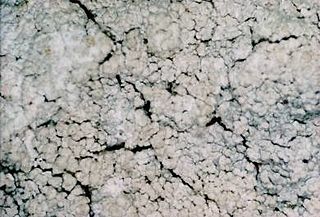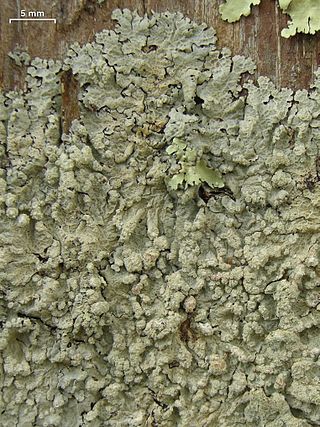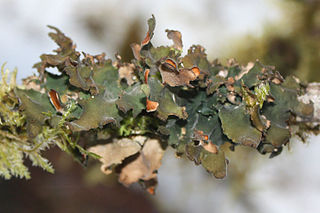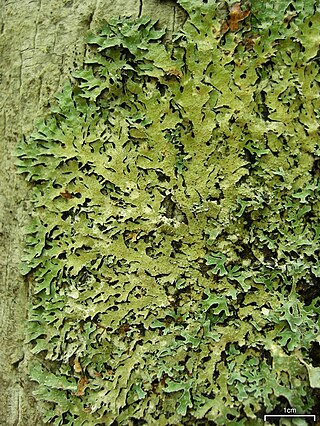
Parmelia is a genus of medium to large foliose lichens. It has a global distribution, extending from the Arctic to the Antarctic continent but concentrated in temperate regions. There are about 40 species in Parmelia. In recent decades, the once large genus Parmelia has been divided into a number of smaller genera according to thallus morphology and phylogenetic relatedness.

Cetrelia is a genus of leafy lichens in the large family Parmeliaceae. They are commonly known as sea-storm lichens, alluding to the wavy appearance of their lobes. The name of the genus, circumscribed in 1968 by the husband and wife lichenologists William and Chicita Culberson, alludes to the former placement of these species in the genera Cetraria and Parmelia.

Parmotrema is a genus of lichen belonging to the family Parmeliaceae. It is a large genus, containing an estimated 300 species, with a centre of diversity in subtropical regions of South America and the Pacific Islands.

Punctelia is a genus of foliose lichens belonging to the large family Parmeliaceae. The genus, which contains about 50 species, was segregated from genus Parmelia in 1982. Characteristics that define Punctelia include the presence of hook-like to thread-like conidia, simple rhizines, and point-like pseudocyphellae. It is this last feature that is alluded to in the vernacular names speckled shield lichens or speckleback lichens.

Lepraria is a genus of leprose crustose lichens that grows on its substrate like patches of granular, caked up, mealy dust grains. Members of the genus are commonly called dust lichens. The main vegetative body (thallus) is made of patches of soredia. There are no known mechanisms for sexual reproduction, yet members of the genus continue to speciate. Some species can form marginal lobes and appear squamulose. Because of the morphological simplicity of the thallus and the absence of sexual structures, the composition of lichen products are important characters to distinguish between similar species in Lepraria.
Menegazzia cincinnata is a species of foliose lichen from southern South America. It was first scientifically described by Swedish lichenologist Erik Acharius as Parmelia cincinnata. Friedrich August Georg Bitter transferred it to the genus Menegazzia in 1901.

Lichens are symbiotic organisms made up of multiple species: a fungus, one or more photobionts and sometimes a yeast. They are regularly grouped by their external appearance – a characteristic known as their growth form. This form, which is based on the appearance of vegetative part of the lichen, varies depending on the species and the environmental conditions it faces. Those who study lichens (lichenologists) have described a dozen of these forms: areolate, byssoid, calicioid, cladoniform, crustose, filamentous, foliose, fruticose, gelatinous, leprose, placoidioid and squamulose. Traditionally, crustose (flat), foliose (leafy) and fruticose (shrubby) are considered to be the three main forms. In addition to these more formalised, traditional growth types, there are a handful of informal types named for their resemblance to the lichens of specific genera. These include alectorioid, catapyrenioid, cetrarioid, hypogymnioid, parmelioid and usneoid.

Crespoa is a genus of five species of lichen in the family Parmeliaceae. Species in this genus are characterized by having an upper thallus surface that is wrinkled and reticulately ridged to coarsely foveolate.

Nephroma resupinatum, commonly known as the pimpled kidney lichen, is a species of foliose lichen in the family Peltigeraceae. It was first described by Carl Linnaeus in his 1753 work Species Plantarum as Lichen resupinatus. Erik Acharius transferred it to the genus Nephroma in 1810.

Punctelia rudecta, commonly known as the rough speckled shield or the speckleback lichen, is a North American species of foliose lichen in the family Parmeliaceae. This species can be readily identified by the light color of the thallus underside, the relatively large lobes at the edges of the thallus, and the tiny white pores present on the top of the thallus that are characteristic of the genus Punctelia. The lichen is quite abundant and widespread in the eastern and southeastern United States, although it also occurs in Canada and northern Mexico, but is less common in these regions. The lichen usually grows on bark, and less commonly on shaded rocks. There are several lookalike Punctelia species; these can often be distinguished from P. rudecta by differences in distribution or in the nature of the reproductive structures present on the thallus.

Calicium trabinellum, commonly known as the yellow-collar stubble lichen, is a widespread species of pin lichen in the family Caliciaceae. It was first described by Swedish lichenologist Erik Acharius in 1803 as Calicium xylonellum ß trabinellum. He made the new combination Calicium trabinellum in a later chapter of the same publication.

Parmelia ernstiae is a species of foliose lichen in the family Parmeliaceae. It occurs in Europe.

Parmelia omphalodes is a species of foliose lichen in the family Parmeliaceae. It is one of the several dozen lichen species first described in 1753 by Carl Linnaeus. Swedish lichenologist Erik Acharius transferred it to the genus Parmelia in 1803. The lichen is widely distributed, having been recorded in Asia, Africa, Europe, and North and South Americas. Morphologically similar–but genetically distinct–species include Parmelia discordans and P. pinnatifida.

Punctelia borreri is a species of foliose lichen in the family Parmeliaceae. It is a common and widely distributed species, occurring in tropical, subtropical, and temperate regions of Africa, Asia, Europe, North America, Oceania, and South America. The lichen typically grows on bark of deciduous trees, and less commonly on rock. Some European countries have reported increases in the geographic range or regional frequency of the lichen in recent decades, attributed alternatively to a reduction of atmospheric sulphur dioxide levels or an increase in temperatures resulting from climate change.

Lepraria incana is a species of dust lichen in the family Stereocaulaceae. First described scientifically by Johann Jacob Dillenius in 1741, and then formally by Carl Linnaeus in 1753, it is the type species of the genus Lepraria. The thallus of this species is green to greyish-green, and powdery – as if made of tiny granules. These granules are soredia, which are asexual reproductive structures. Like most members of genus Lepraria, the lichen has few distinguishing features, lacking both a medulla and sexual reproductive structures (apothecia). Chemically, the lichen is characterised by the presence of the secondary chemicals known as divaricatic acid and zeorin.
Parmelia rojoi is a species of foliose (leafy), saxicolous (rock-dwelling) lichen in the large family Parmeliaceae. It is known to occur in a couple of humid forests in southern Spain. It is quite similar in appearance to the more widespread Parmelia saxatilis, but has a more fragile thallus and smaller isidia.

Solorina crocea, commonly known as the orange chocolate chip lichen, is a species of terricolous (ground-dwelling) and foliose (leafy) lichen in the family Peltigeraceae. The lichen, which was first formally described by Carl Linnaeus in 1753, has an arctic–alpine and circumpolar distribution and occurs in Asia, Europe, North America, and New Zealand. It generally grows on the bare ground in sandy soils, often in moist soil near snow patches or seepage areas. Although several forms and varieties of the lichen have been proposed in its history, these are not considered to have any independent taxonomic significance.

Parmelia squarrosa, commonly known as the bottlebrush shield lichen, is a species of foliose lichen in the family Parmeliaceae. It occurs in east Asia, Europe, and eastern North America, where it typically grows on tree bark, much less frequently on rocks, and rarely on moss. Because of its abundance, widespread distribution, and stable populations, it has been assessed as a species of least concern by the International Union for Conservation of Nature. Parmelia saxatilis is quite similar in appearance Parmelia squarrosa and the latter was quite often confused with the former, especially in herbarium collections. Molecular phylogenetic analysis proved the genetic distinctness between the two species, which are morphologically distinguished by difference in rhizine structure.

Chrysothrix chlorina, the sulphur dust lichen, is a species of leprose (powdery) crustose lichen in the family Chrysotrichaceae. Originally described scientifically by the Swedish lichenologist Erik Acharius over 200 years ago, it has been shuffled to many different genera in its taxonomic history before finally being transferred to Chrysothrix in 1981. The lichen has a circumboreal distribution, meaning it occurs in northern boreal regions across the planet. It is typically saxicolous (rock-dwelling), particularly on the underside of rock overhangs, but has in rare instances been recorded growing on bark and various other surfaces.
Calicium corynellum is a species of pin lichen in the family Caliciaceae. It is found scattered across parts of Europe, North America, and Asia, where it grows on rock surfaces in shaded and humid locations.

















